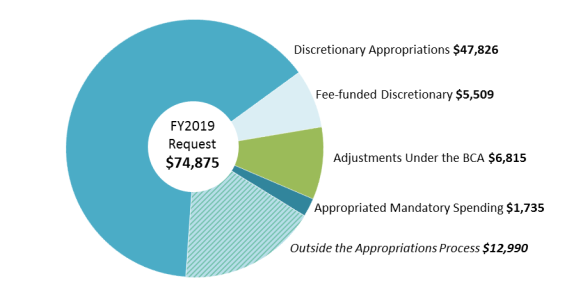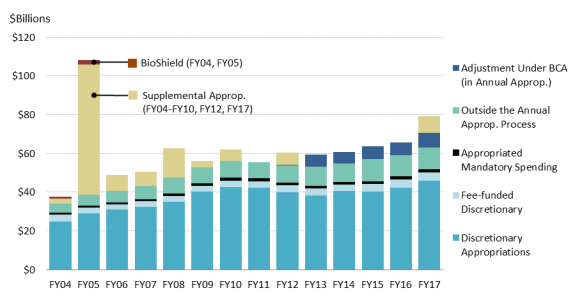DHS Budget v. DHS Appropriations: Fact Sheet
Changes from April 2, 2018 to April 17, 2019
This page shows textual changes in the document between the two versions indicated in the dates above. Textual matter removed in the later version is indicated with red strikethrough and textual matter added in the later version is indicated with blue.
A significant portion of the Department of Homeland Security's (DHS's) budget is not fully reflected in the net discretionary spending level of the annual DHS appropriations act. Some components, such as the Transportation Security Administration, rely on fee income or offsetting collections to support a significant amount of their activities. Less than 4% of the budget for U.S. Citizenship and Immigration Services is provided through the annual appropriations act—the rest is derived from fee income.
Figure 1 highlights the range of funding mechanisms that support the overall DHS budget and provides a visual comparison of their relative size. It presents a breakdown of the Donald J. Trump Administration's FY2019FY2020 budget request, showing the discretionary appropriations subject to the discretionary spending limits, discretionary spending funded through fees, discretionary spending not subject to discretionary spending limits due to special designation under the Budget Control Act (BCA), and appropriated mandatory spending. All of these mechanisms rely on the appropriations process to provide budget authority to the department. A patterned wedgeThe lighter bar shows the amount of resources to be provided outside the annual appropriations process, through mandatory spending, trust funds, and user fees. The amounts shown in this graphic are derived from the Administration's budget request documents, and therefore do not exactly mirror the data presented in congressional documents, which are the source for most of the other data presented in CRS reports on appropriations measures.
|
Figure 1. DHS Gross Budget Breakdown: (millions of dollars of budget authority, rounded) |
 |
|
Source: CRS analysis of the Notes: BCA = the Budget Control Act (P.L. 112-25). Amounts may not sum to totals due to rounding. The amounts shown in this graph are derived from the Trump Administration's budget request documents, and therefore do not exactly mirror the data presented in congressional documents, which are the source for most of the other data presented in CRS reports on appropriations measures. Totals do not include effect of $4 million in changes in mandatory programs or $250 million in proposed rescissions. |
This range of different funding mechanisms contributing to the DHS budget is not a new development. From the establishment of the department in the middle of FY2003, when the initial resources for the department were provided via transfer, DHS has been dependent in part on resources provided beyond its funding stream subject to the annual appropriations process.
Figure 2 provides a historical breakdown of the actual spending reported by DHS in its budget documentation, outlining the same categories as above, plus the impact of supplemental appropriations, from the first full-year appropriation for the department (FY2004) through the most recently completed fiscal year for which data are available (FY2017FY2018). While the amount of funding provided for DHS activities outside the appropriations process more than doubled from FY2004 to FY2016,1FY2018, rising from $4.7 billion to $10.812.4 billion, this was not the primary factor in the 7598% growth of the annual DHS budget over the same time period. Annual discretionary appropriations,1 not including fee-funded discretionary spending or spending exempt from discretionary spending limits under the BCA, rose roughly $17.721.2 billion (7278%) over the same time period.
|
Figure 2. DHS Budget Breakdown, Actual, FY2004- (budget authority unadjusted for inflation) |
 |
|
Source: CRS analysis of DHS Budget in Brief documents from FY2006 to Notes: BCA = the Budget Control Act (P.L. 112-25). Does not include rescissions of prior-year budget authority. The amounts shown in this graph are derived from several Administrations' budget request documents, and therefore do not exactly mirror the data presented in congressional documents, which are the source for most of the other data presented in CRS reports on appropriations measures. |
Author Contact Information
Footnotes
| 1. |
|